This post may contain affiliate links. Please read our disclosure policy.
How to make a cheese board in just minutes—perfect for your next dinner party, the holidays, and special events! This post includes the best cheese for cheese boards, several themed cheese board ideas, and my favorite tips, tricks, and ideas for putting together the ultimate (stress-free!) cheese board!
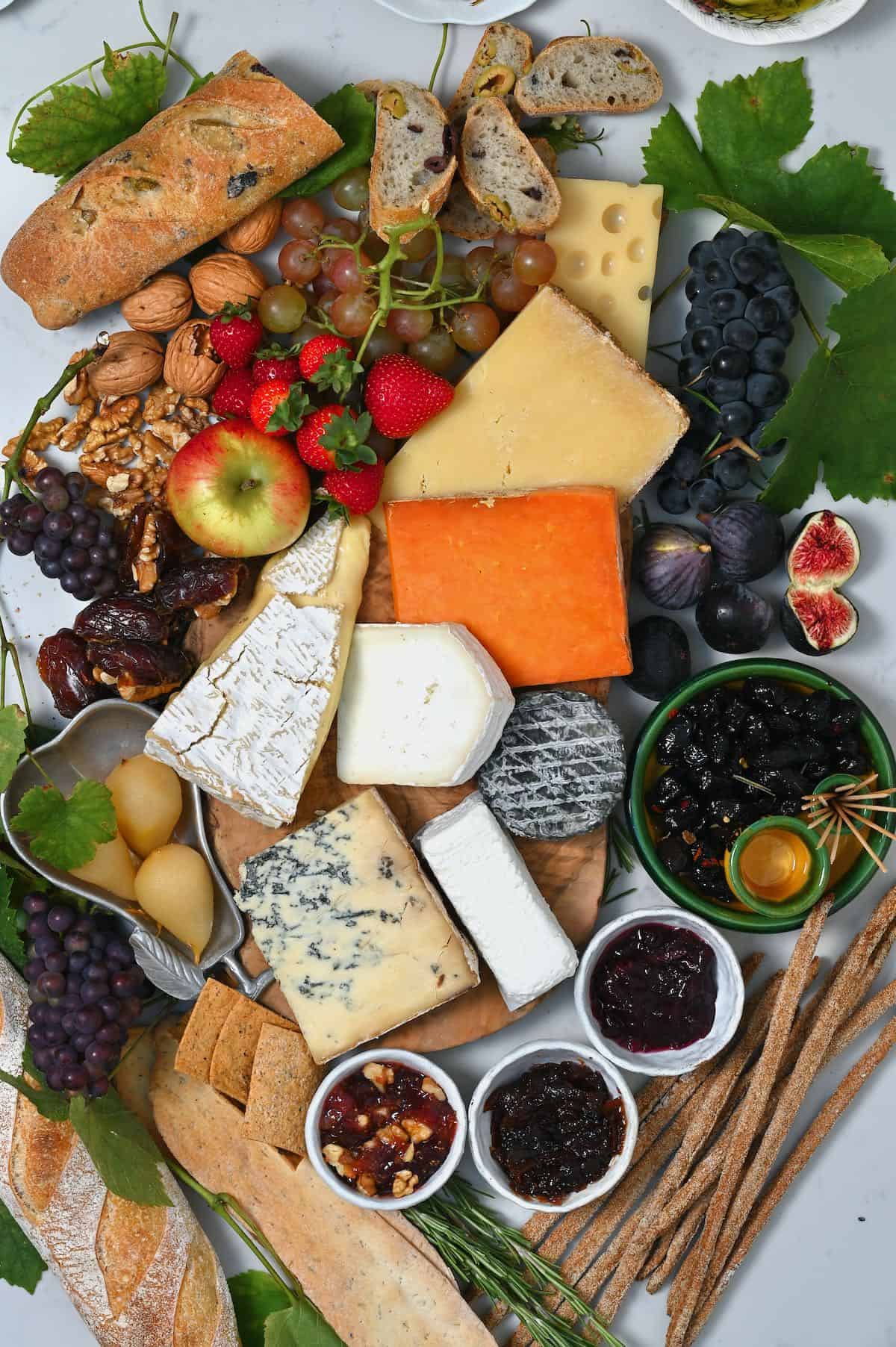
A homemade cheese board is a perfect accompaniment to any special occasion. With a blend of flavors, textures, and colors, it is a sensory experience catering to a wide variety of palates. Best of all, you can prepare a simple or fancy cheese board and make almost endless ingredient combinations based on occasion and budget.
It’s easy to become overwhelmed with the abundance of charcuterie board and cheese board/cheese platter images online. Especially when it’s your first time assembling one. And, while they may seem daunting to prepare, it can take as little as 5 minutes to assemble a simple fruit, cheese, and cracker platter. Especially with some top tips, ingredient suggestions, and ideas for cheese boards.
Want to save this recipe?
What is a Cheese Board vs. a Charcuterie Board?
When it comes to grazing boards, the options are plentiful – usually coming under one of several banners, including a cheese board (alongside charcuterie boards and grazing platters). But what exactly is the difference between a cheese board and a charcuterie board?
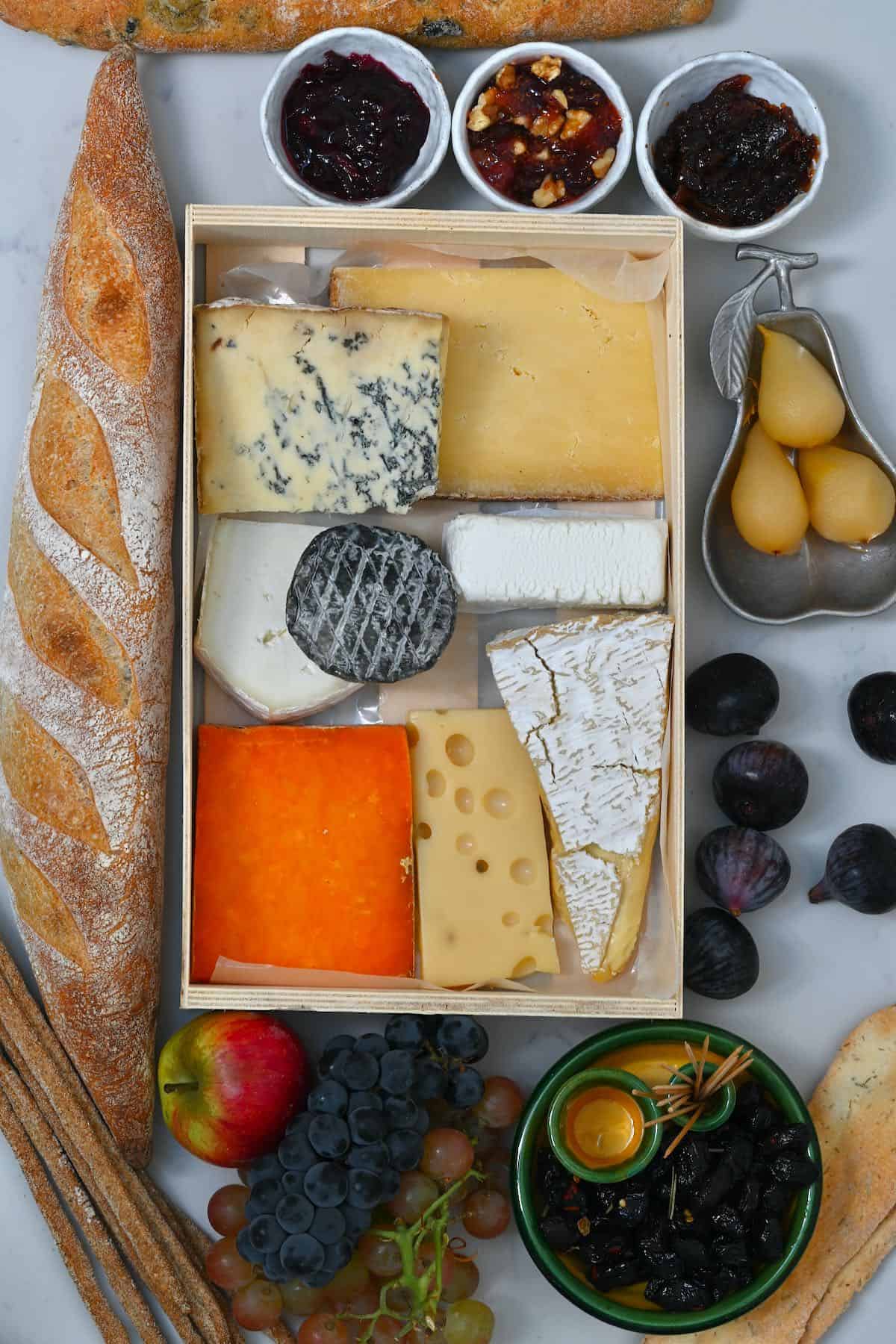
The truth is, not that much apart from the “emphasis” of the “main element” on the board. In the case of charcuterie boards, that is traditionally a selection of cured meats with ingredients that pair with those meats. In comparison, a cheese board, unsurprisingly, focuses on a selection of cheese paired with complementary items (and not always meat).
While the various snack platters share many similarities and crossovers of ingredients, there is one key difference. Charcuterie boards typically include more savory elements (like vegetables and savory dips), whereas cheese boards often rely on sweeter elements (like fruits/jams/preserves) to pair with the tangy/salty cheeses. Salty and/or briny elements (like cured/pickled items) also pair well.
What to Put on a Cheese Board?
The general idea is to provide a good combination of flavors, textures, and even colors to provide both contrast and balance. This makes them a little “more” than your average Christmas cheese and cracker platter.
However, the exact ingredients of your cheese board will depend on the time of year, holidays, or theme (which are plentiful). The resulting fruit and cheese platter is perfect for serving at any special occasion, party, or large gathering. You can also prepare a cheese board gift!
The Best Cheese for Cheese Boards
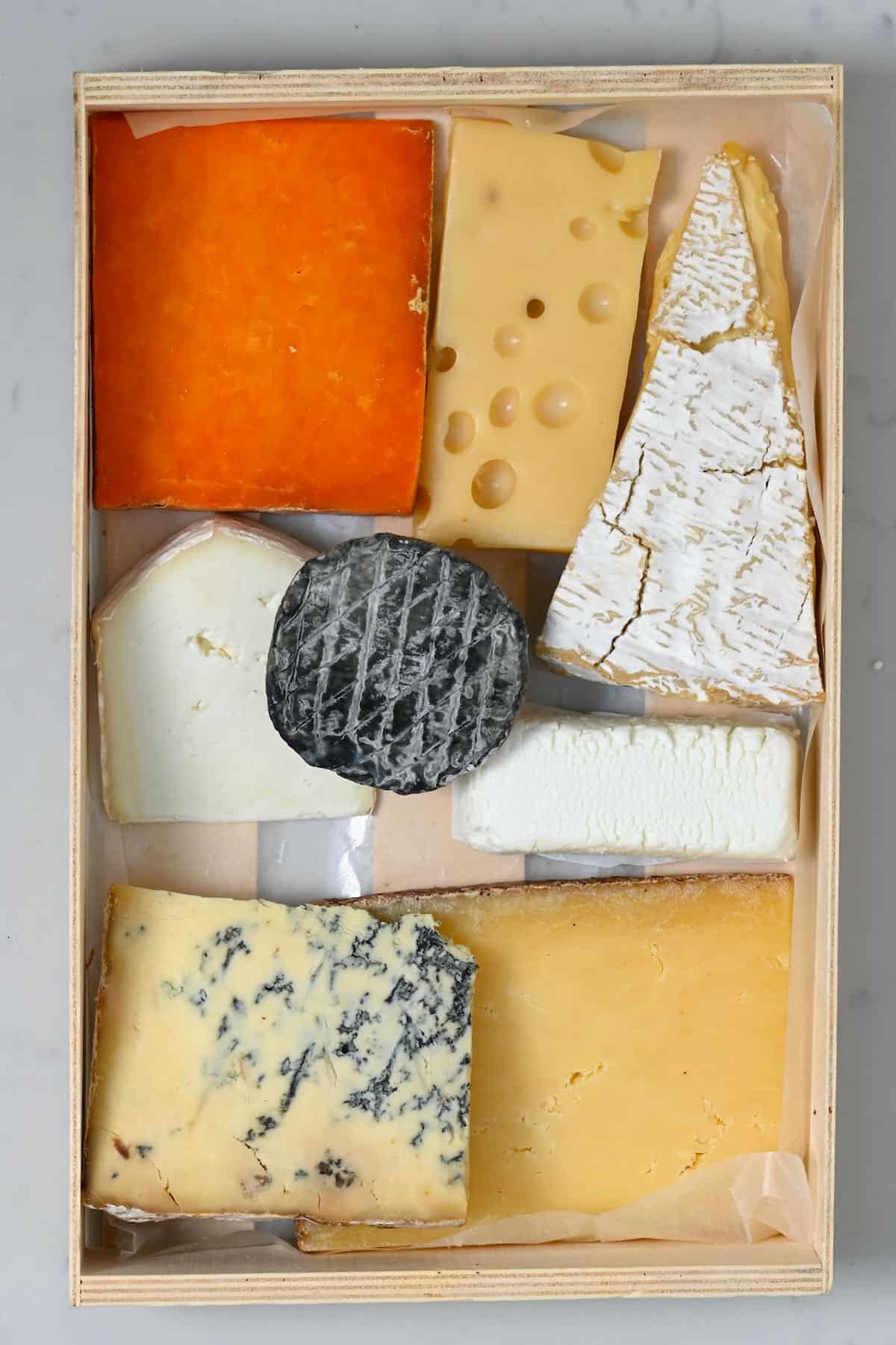
When selecting the best cheeses for cheese board ideas, it’s best to choose a variety of flavors and textures: i.e., mild vs. mature; different types of milk – goat, cow, sheep; and soft vs. hard. Options include:
- Spreadable: any cream cheese or soft, spreadable cheese (this include cream cheese logs) like regular cream cheese, labneh, flavored cream cheese, whipped ricotta, and Boursin.
- Soft: goat cheese (chevre), brie, camembert, burrata, mozzarella cheese (fresh), feta, etc.
- Semi–firm: Mild options include gouda, mild cheddar, Havarti, leer dammer, asiago, Monterey Jack, and Edam (which can be sharp, too). Mature/sharp options include gruyere, mature cheddar, and provolone.
- Firm/Hard: Manchego, parmesan (dried), Comte, pecorino, and Romano
- Blue: Stilton, Roquefort, or gorgonzola.
How much do you need? I recommend 3-4 different ones for a small cheese board, 5-6 for a medium/large, and up to 7 for a very large cheese board.
Other Ingredients/Components
All of the below amounts are for a medium/large cheese board. For a small cheese board, I recommend using 1-2 of each.
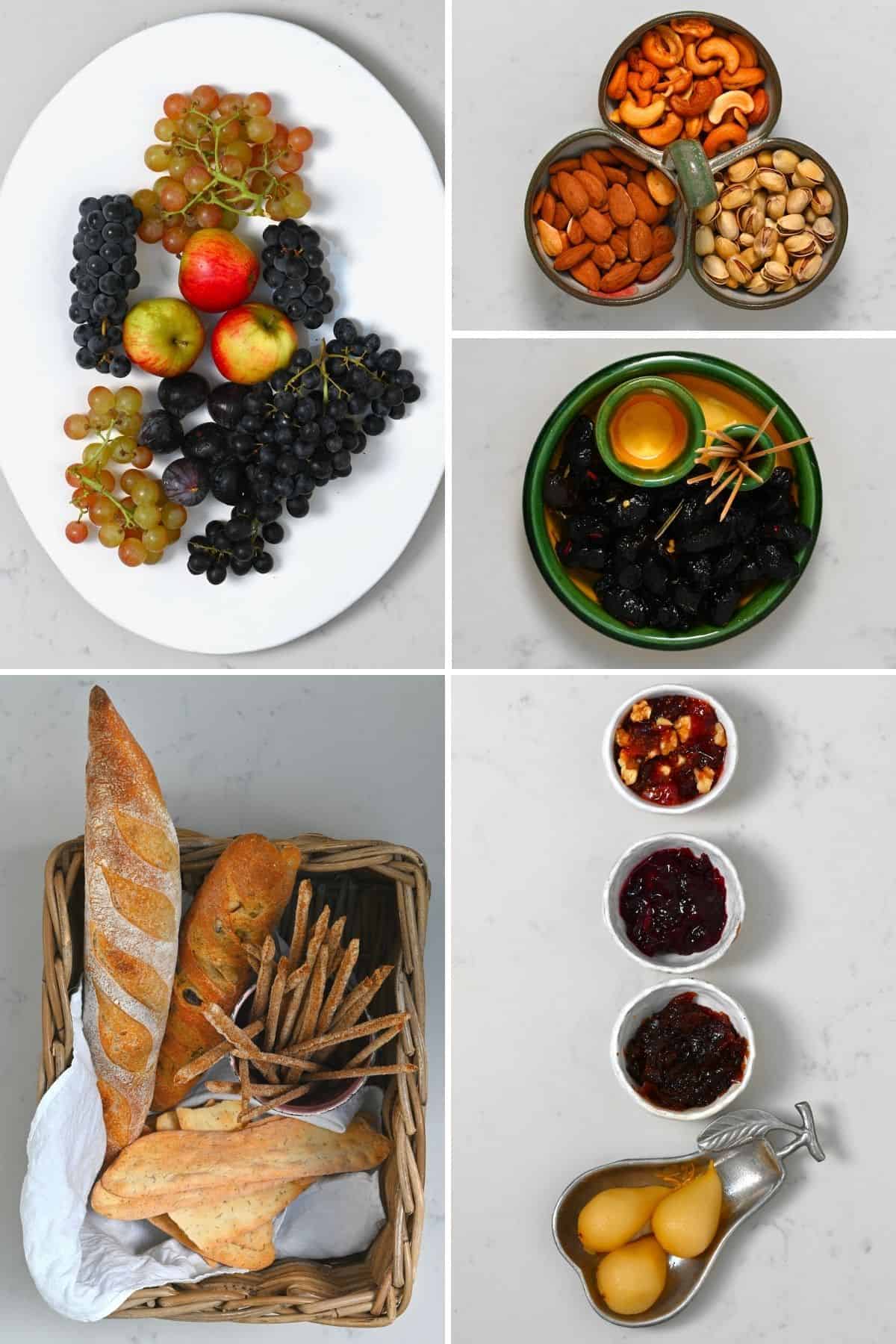
- Fresh fruits (choose 2-3): grapes, apple/pear slices, berries (blueberries, raspberries, blackberries, strawberries, etc.), figs, cherries, melon slices, persimmon, kiwi, pomegranate, grilled peaches, plums, cherry tomatoes (technically a fruit!)
Fun fact: grapes were traditionally included on a cheese board as a palate cleanser between each cheese rather than to eat WITH the cheese.
- Dried fruits (choose 1-2): fates, apricots, cherries, figs, mango, and even crisp, dry fruits like dehydrated banana chips.
- Nuts/Seeds (choose 1-2): you can use raw or roasted (and salted) nuts/seeds, including walnuts, almonds, cashews, pistachios, macadamia nuts, pecans, Brazil nuts, pepitas, etc. You could also use candied nuts, chocolate-covered nuts, smoked nuts/seeds, or other seasoned nuts/seeds.
- Nibbles (choose 2-3): olives, artichokes, pickles (pickled red onions, pickled cucumbers, pickled garlic), cornichons, roasted peppers slices, etc.
- Bread (choose 2-4): breadsticks, sliced crusty bread, no-knead focaccia bread, crackers (I recommend using one fairly “plain” cracker like a water cracker or grain crackers and an artisanal cracker that’s a bit more “exciting”), seed crackers, lentil crackers, parmesan crisps, potato chips, pita chips, pita bread, crostini, etc. You could also use dried fruit/vegetable “crisps” like these beetroot chips, kale chips, etc.
- Sauces/Dips (choose 3-5): honey/ dandelion honey (and honeycomb), hot sauce, chutney, preserves, mustard, tapenades, and jams/jellies (like strawberry jam, raspberry jam, cherry, blackberry jam, apricot, fig jam, quince, or even chili or tomato jam/jelly), pesto (traditional basil pesto or vegan pesto). You could also use fermented items like fermented garlic in honey and garlic and chili-infused honey.
Top Tip: Onion marmalade is a great addition to fruit, cheese, and cracker platters, as it pairs well with most cheeses. Likewise, aged cheddar pairs well with most of the accompaniments: honey, apple/pear, jams, nuts, grapes, dates, etc.
- Extras: dark chocolate, tomato confit or garlic confit, sun-dried tomatoes, cucumber, corn nuts, etc.
- Garnish: You can dress up the fruit and cheese platter with extra greenery, such as fresh herbs (rosemary springs, fresh parsley, and other herbs), micro herbs, rocket (or other salad greens), or even decorative touches like vine leaves.
Themed Options and Variations
How to make a seasonal cheese board: I love to allow the seasons to influence the simple or fancy cheese platter offerings. Here are just a few cheese board ideas for seasonal additions.
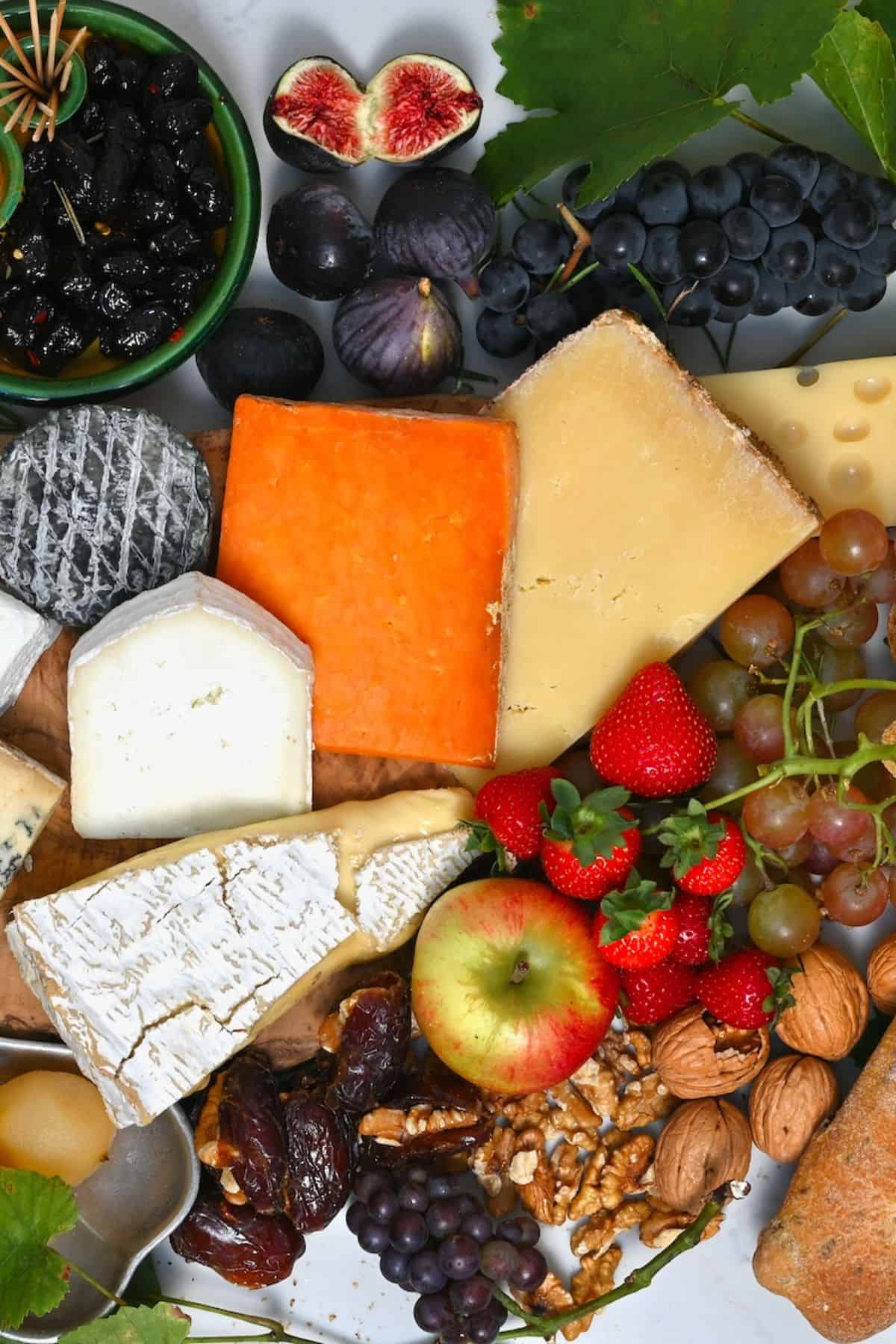
- Spring/Summer: fresh berries, peaches (grilled or raw), in-season cherry tomatoes, radishes, fresh apricots, cantaloupe, and even fresh basil (combine with the cherry tomatoes and some mozzarella to make little Caprese skewers).
- Fall: apple and pear slices, roasted squash/pumpkin slices, grapes, apple butter, etc.
- Winter: pomegranate seeds, clementines, cranberry sauce, figs, fig jam, dried cranberries, roasted Brussels sprouts.
Cheeseboard charcuterie: I’ve kept this at the bottom of the list, as I don’t often add any meat to my cheese boards (because then it’s basically a charcuterie board). However, if you want to add some meat, you could use Salami, prosciutto, cured beef/ham, nduja, mortadella, soppressata, etc. You could also add a spreadable like pâté (choose 2-3).
Vegetarian cheese board: I don’t tend to add any meat to cheese boards anyhow. However, what you do have to look out for are cheeses that contain rennet. Otherwise, these cheese boards are naturally vegetarian.
Vegan cheeseboard: all of the guidelines and tips mentioned in this post apply for a vegan cheese board, too – just use dairy-free cheese instead (like this vegan cashew cheese wheel, smoky vegan cheddar cheese, ricotta cheese, or vegan mozzarella cheese).
You can also prepare themed cheese platters based on the holidays (i.e., Christmas cheeseboard, Thanksgiving cheese board) or on the region (French cheeseboard, Italian cheese board, etc.)/
How to Make a Cheese Board?
The unofficial first step of preparing any board/platter is to choose the board. The options for this are plentiful, with slate and wooden boards being my favorite options for any simple cheese platter. You can use square, round, rectangular boards, etc. If you plan to transport the fruit and cheese platter or have lots of tiny elements, I recommend using a “tray”. That way, the elements won’t risk rolling off the board and can easily be covered for transportation.
There’s no need to buy a specific “cheese board” if you have a good cutting board or serving tray at home. Even a sheet pan can work in a pinch!
Then it’s time to assemble the cheeseboard. There are two main styles for doing this. The first is in the style of a charcuterie board – with items varied across the board. The second is a cheese-centric cheese platter.
Method One: Mixed Board
Step 1: Place Any Bowls/Jars
I like to place these first to get an idea of a layout for my remaining ingredients. I make sure to place bowls and jars of different shapes/heights in areas around the board. Place the tallest items towards the center of the board so they don’t get in the way of grabbing other items. These will be filled with pickled items, sauces, spreads, olives, etc.
You can fill them immediately and cover them with plastic wrap until you’re ready to serve or add the items just before serving.
Step 2: Place the Cheese
Next, it’s time to place the cheeses. Make sure to spread them across the board and separate them in terms of shape and size, too. You can keep the cheeses as whole wedges/wheels or slice some or all of the cheese.
You might also want to add certain cheeses besides certain complimentary spreads. For example, brie can go beside honey. Aged cheddar would work next to most jam/jellies, etc.
Serve the cheese at room temperature: remove the cheese from the fridge 30 minutes before serving to allow the cheese to come to room temperature for the optimal texture and flavor. You can wrap it in plastic wrap/beeswax wrap to stop them from drying out.
Note: if you’re adding and charcuterie meats, then add them now too. I like to experiment with different shapes for better visual appeal by rolling and folding the meats. You can also prop them up against bowls/plates to prop them up for extra height.
Step 3: Place the Fruits and Bread
Next, it’s time to place the fruit. I like to add the largest items first, like grapes still attached to the stems, etc. Next, spread out the fruit so no fruit is directly next to another, and spread out the colors, sizes, etc.
Keep fruit fresh: if you’re serving any fruits that brown when sliced (like apples and pears), then make sure to “treat” them to avoid browning. You can do this in several ways. The first has you soak the slices in citrus juice (lemon, pineapple, or orange) – though it will impact flavor slightly. Secondly, you could soak them in a mixture of honey and water (2 Tbsp honey per 1 cup water). Alternatively, you can purchase a fruit preserver/produce protector (though they can be pricey).
After placing the fruits, it’s time to lay down the “bread.” Since these can take up a lot of space, I usually fan out a handful of crackers. Then keep a separate platter nearby with extra bread and crackers for guests to grab.
Make sure not to place the bread/breadsticks/crackers next to wet ingredients like fruit slices/pomegranate. Otherwise, they make become “soggy” over time.
Step 4: Add the Nuts/Seeds and Garnish
At this point, it’s time to fill in any remaining gaps on the board. Do so with dried nuts/ seeds, other small items, and garnish.
I first add the nuts/seeds. Spread the different kinds in different areas of the boards.
Then, you can fill in any remaining blank spots on the board with a garnish: fresh herbs (like rosemary sprigs) or greenery will work well in these spaces.
Step 5: The Finishing Touches
Finally, make sure to label the cheeses (and optionally spreads/sauces if you’re not serving them from their jars). You can do this with cheese “markers” or a simply DIY setup with toothpicks and labels.
And lastly, but very importantly, add any utensils to the board. It would be best to have toothpicks for pickled and smaller items, cheese knives, spoons for dips, etc. Make sure you have spares, just in case.
Note: If you have any leftovers, you can use them for wraps, grilled cheese, and salads or use the individual items in other recipes.
Method Two: Cheese Platter
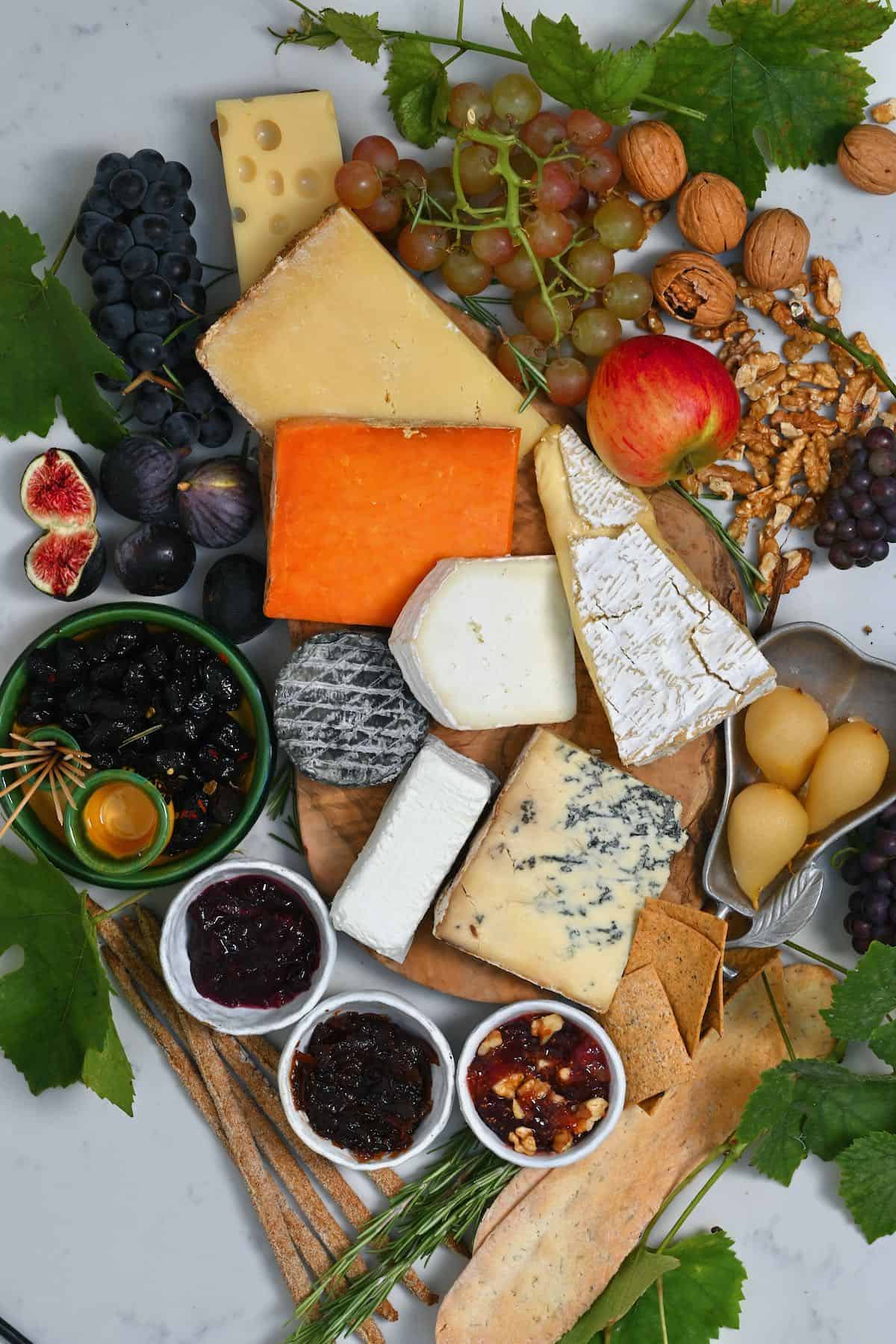
For this method, the idea is to keep all the cheese on a single board/tray in the center of the display. You can then build up the other ingredients around that – either keeping them together or spreading them apart. That way it’s easy to replenish items without having to overly worry about the creative placement of each individual item.
I find this works best for large “buffet” style events rather than smaller dinner parties (as I was preparing for in these images). However, feel free to also use this method for smaller events and simply scale it down.
Don’t keep a cheeseboard sitting out for more than 2-3 hours, when possible. While any leftover hard cheese is usually OK to wrap and refrigerate, you should discard softer cheeses.
FAQs
Around 5-7 are included for a medium/large cheese board with a variety of flavors and textures (soft, semi-hard, and hard). For a small cheese board, I’d recommend 3-4.
I recommend between 2-3oz (56-85g) per person as a post-meal snack. If you’re serving the cheese plate as the meal, then 7-8oz around (200-225g) per person. Read above in the blog post for guidelines on how many ingredients to include for a medium/ large cheese board.
There are no set rules on this, though there are differing opinions. While including large pieces of cheese and knives for guests to cut their own pieces is easiest (and allows them to choose their portion size), it will likely lead to a messy board. In comparison, providing ready-sliced cheese means equally portioned amounts that are easy to grab guests. However, sliced cheese will dry out quickly (especially if you end up with any leftovers). For the best of both worlds, I recommend slicing the first 1/3-1/2 of your cheeses.
For any wheel-shaped cheese, I recommend slicing thin wedges (like thin cake slices). In the case of softer cheese wheels (like brie), I recommend cutting a large wedge first, then slicing diagonal pieces from that wedge. For logs, simply slice thin slices off the log – similarly for rectangular cheese – either make large slices or slice into small squares (or both).
Yes – If there is no meat involved, you can assemble the cheese platter a day in advance and store, covered, in the fridge (avoid slicing the cheese too early, or it could become dry).
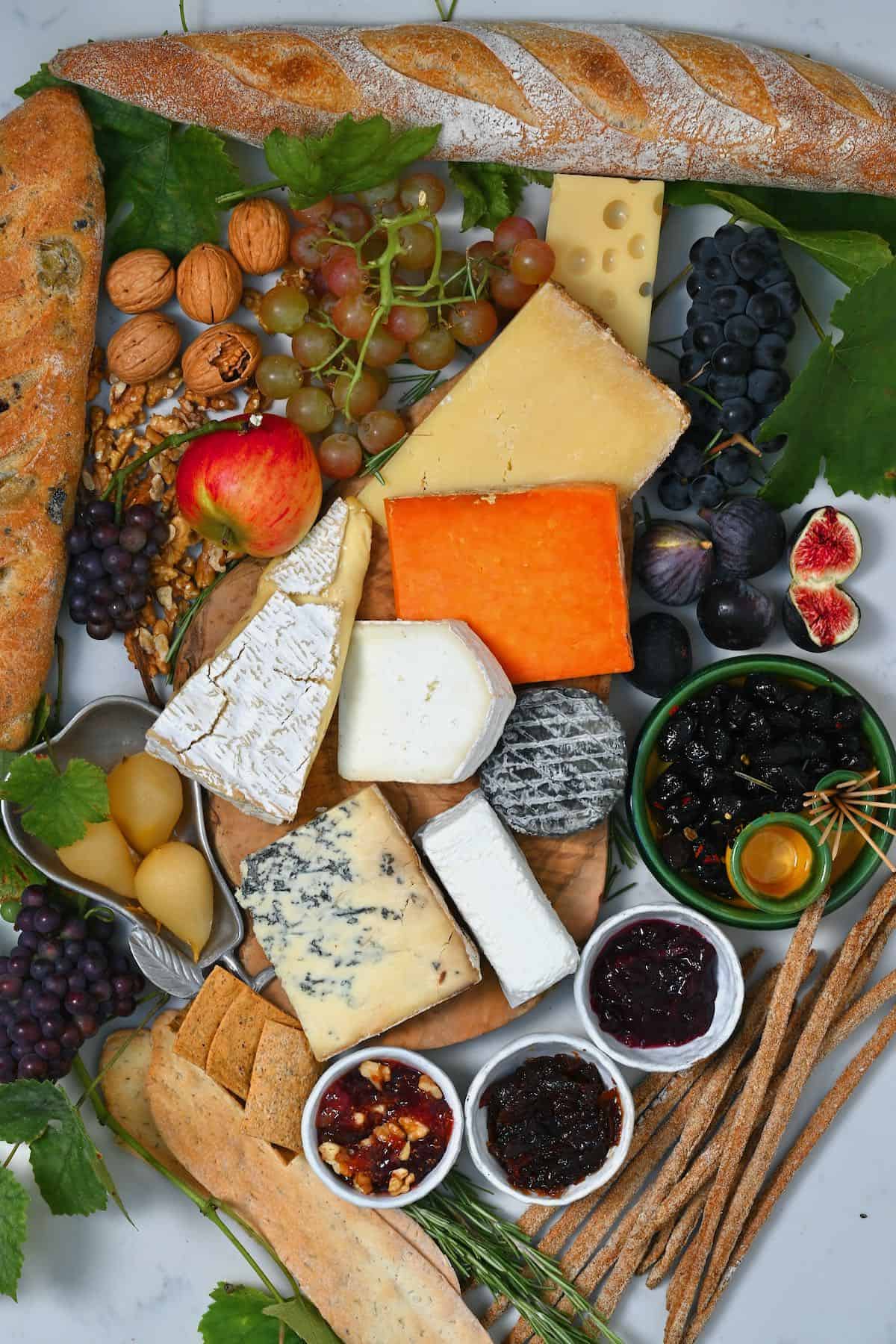
Top Tips for Preparing a Cheese Board
- It’s all about balance and contrast: choose a combination of ingredients that play with different textures (soft, crumbly, hard, crunchy) and flavors (sweet, savory, tangy, spicy) for the best results and flavors that contrast and balance.
- Label please: if you don’t want to spend all evening repeating yourself, it’s a great idea to label the various cheese and spreads/sauces on the board. You can purchase specific “markers” for this or use a toothpick and label or other DIY options.
- Balance the cheese amount: rather than making a fruit and cheese platter with tons of different cheese varieties in tiny amounts; it’s better to use fewer types in larger portions (then you’re less likely to run out of any one cheese!)
- Visit a cheesemonger: all the above information/tips have been compiled from experience and research over the years. However, for the best advice, you may want to visit your local cheesemonger. Let them know your event and themes, and they’re usually more than happy to curate a cheese selection within your theme and budget.
- Serve the cheese incrementally: as a general rule, they say you should have the cheese out for longer than 2-3 hours. However, many events will go on for longer than that. For that reason, it can be a good idea to only place a portion of the cheese on the cheese board. Top it up when you notice ingredients getting low. That way, the cheese stays fresh, and you don’t end up with any unnecessary waste. Alternatively, make two smaller platters instead or one large and leave one in the fridge until the first starts to run out.
- To avoid waste: plan out the amount of each ingredient you need. Check the FAQs for my suggestion cheese amount per person. As a general guide, supply a “handful” of extra “bits n’ bobs” with the cheese and a couple of tablespoons of sauces. You can keep some extras in the fridge if needed.
- Have fun: Lastly, and most importantly, don’t let this process stress you out. Experiment with different pairings and have fun. Use what you think will work together and provide lots of tasty elements for all your guests. I rarely make the same platter two times in a row. I’ve been known to get “creative” with the rules and guidelines!
More appetizer recipes
If you try this method for how to make a cheese board (mixed cheese platter), I’d love to hear your thoughts/questions below. Also, I’d appreciate a recipe card rating below, and feel free to tag me in your recipe recreations on Instagram @Alphafoodie!
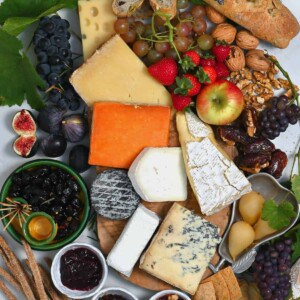
How To Make a Cheese Board – Standard Cheese Platter
Ingredients
- cheese – mixture or soft, semi-firm, and firm (5-6 for medium/large cheese board); add 2-3oz cheese per person. Emmental, Comté, goat cheese, Stilton, Brie (or Camembert), cheddar (or Gouda)
- breads – crackers, chips, bread (2-4 types) A selection of hard crackers and chips
- fruit (dried 1-2, fresh 2-3) grapes, apple/pear, stuffed dates (with almonds/walnuts)
- nuts (1-2 types) walnuts, almonds
- dips/sauces (3-5 types) onion chutney/marmalade, fig jam (or other jams), cranberry sauce
- other olives, pickled ingredients
Check the blog post for all the ingredient possibilities/categories! The ingredients above are just an example cheese board.
Instructions
- The unofficial first step of preparing any board/platter is to choose the board. The options for this are plentiful, with slate and wooden boards being my favorite options for any simple cheese platter. You can use square, round, rectangular boards, etc. If you plan to transport the fruit and cheese platter or have lots of tiny elements, I recommend using a "tray" – that way, the elements won"t risk rolling off the board and can easily be covered for transportation.There's no need to buy a specific "cheese board" if you have a good cutting board or serving tray at home. Even a sheet pan can work in a pinch!
- Then it's time to assemble the cheeseboard. There are two main styles for doing this, the first is in the style of a charcuterie board – with items varied across the board. The second is a cheese-centric cheese platter.
Method One: Mixed Board
Step 1: Place Any Bowls/Jars
- I like to place these first to get an idea of a layout for my remaining ingredients. I make sure to place bowls and jars of different shapes/heights in areas around the board (place the tallest items towards the center of the board so they don't get in the way of grabbing other items). These will be filled with pickled items, sauces, spreads, olives, etc.You can fill them immediately and cover them with plastic wrap until you're ready to serve or add the items just before serving.
Step 2: Place the Cheese
- Place the cheeses. Make sure to spread them across the board and separate them in terms of shape and size, too. You can keep the cheeses as whole wedges/wheels or slice some or all of the cheese.You might also want to add certain cheeses besides certain complimentary spreads. For example, brie can go beside honey. Aged cheddar would work next to most jam/jellies, etc.
- Note: if you're adding and charcuterie meats, then add them now too. I like to experiment with different shapes for better visual appeal by rolling and folding the meats. You can also prop them up against bowls/plates to prop them up for extra height.
Step 3: Place the Fruits and Bread
- Place the fruit. I like to add the largest items first, like grapes still attached to the stems, etc. If you're using any sliced fruits like apple/pear that will brown, then make sure to "treat" them first (check the method in recipe notes). Next, spread out the fruit, so no fruit is directly next to another, spread out the colors, sizes, etc.
- After placing the fruits, it's time to lay down the "bread." Since these can take up a lot of space, I usually fan out some crackers and then keep a separate platter nearby with extra bread and crackers for guests to grab.Make sure not to place the bread/breadsticks/crackers next to wet ingredients like fruit slices/pomegranate – or anything that can cause them to go "soggy" over time.
Step 4: Add the Nuts/Seeds and Garnish
- Fill in any remaining gaps on the board with dried nuts/seeds, other small items, and garnish.I first add the nuts/seeds. Spread the different kinds in different areas of the boards.Then, you can fill in any remaining blank spots on the board with a garnish: fresh herbs (like rosemary sprigs) or greenery will work well in these spaces.
Step 5: The Finishing Touches
- Make sure to label the cheeses (and optionally spreads/sauces if you're not serving them from their jars). You can do this with cheese "markers" or a simply DIY setup with toothpicks and labels.
- And lastly, but very importantly, add any utensils to the board. It would be best to have toothpicks for pickled and smaller items, cheese knives, spoons for dips, etc. Make sure you have spares, just in case.
Method Two: Cheese Platter
- For this method, the idea is to keep all the cheese on a single board/tray in the center of the display. You can then build up the other ingredients around that – either keeping them together or spreading them apart. That way it's easy to replenish items without having to overly worry about the visual appeal and placement of each individual item.I find this works best for large "buffet" style events rather than smaller dinner parties. However, feel free to also use this method for smaller events and simply scale it down.Don't keep a cheeseboard sitting out for more than 2-3 hours, when possible. While any leftover hard cheese is usually OK to wrap and refrigerate, you should discard softer cheeses.
Notes
- It’s all about balance and contrast: choose a combination of ingredients that play with different textures (soft, crumbly, hard, crunchy) and flavors (sweet, savory, tangy, spicy) for the best results and flavors that contrast and balance.
- Label please: if you don’t want to spend all evening repeating yourself, it’s a great idea to label the various cheese and spreads/sauces on the board. You can purchase specific “markers” for this or use a toothpick and label or other DIY options.
- Balance the cheese amount: rather than making a fruit and cheese platter with tons of different cheese varieties in tiny amounts; it’s better to use fewer types in larger portions (then you’re less likely to run out of any of the cheese!)
- Serve the cheese at room temperature: remove the cheese from the fridge 30 minutes before serving to allow the cheese to come to room temperature for the optimal texture and flavor. You can wrap it in plastic wrap/beeswax wrap to stop them from drying out.
- Visit a cheesemonger: all the above information/tips have been compiled from experience and research over the years. However, for the best advice, you may want to visit your local cheesemonger. Let them know your event and themes, and they’re usually more than happy to curate a cheese selection within your theme and budget.
- Serve the cheese incrementally: as a general rule, they say you should have the cheese out for longer than 2-3 hours. However, many events will go on for longer than that. For that reason, it can be a good idea to only place a portion of the cheese on the cheese board. Top it up when you notice ingredients getting low. That way, the cheese stays fresh, and you don’t end up with any unnecessary waste. Alternatively, make two smaller platters instead or one large and leave one in the fridge until the first starts to run out.
- To avoid waste: plan out the amount of each ingredient you need. Check the FAQs for my suggestion cheese amount per person. As a general guide, supply a “handful” of extra “bits n’ bobs” with the cheese and a couple of tablespoons of sauces. You can keep some extras in the fridge if needed.
- Have fun: lastly, and most importantly, don’t let this process stress you out. Experiment with different pairings and have fun. Use what you think will work together and provides lots of tasty elements for all your guests. I rarely make the same platter two times in a row. I’ve been known to get “creative” with the rules and guidelines!

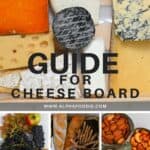
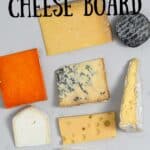
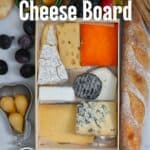
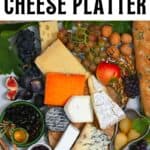










Here in the UK we also pair hard cheeses, typically Wensleydale, Cheddar with rich fruit cake. So you’ll often see this around after Christmas when the Christmas cake (minus the icing) can be eaten up.
Give it a try, it’s delicious!
Hi Karen,
Thank you so much for the recommendation – will keep it in mind for the next time I prepare a cheese board 🙂